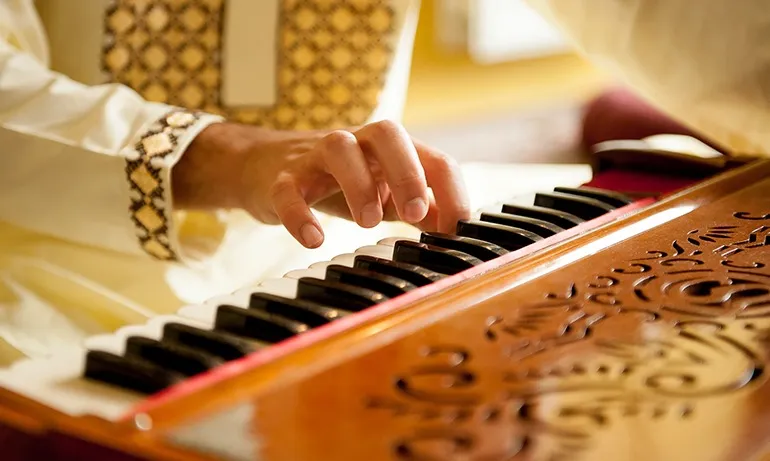Are you drawn to the beautiful world of bhajans and want to learn how to play them on the harmonium? You're in the right place! I've been playing harmonium for bhajans for over 15 years, and I'm excited to share everything I've learned with you. When I first started, I found it challenging to find good resources that broke down the process into simple steps. That's why I created this guide to help beginners master the harmonium for bhajan singing.
What You'll Need to Start Playing Harmonium for Bhajans
Before we dive into learning how to play harmonium for bhajans, let's make sure you have everything you need:
- A good quality harmonium (I recommend starting with a medium-sized one)
- A comfortable place to sit cross-legged or on a chair
- Basic knowledge of musical notes (don't worry, I'll explain this)
- Patience and regular practice time
- A collection of simple bhajans to start with
I remember when I bought my first harmonium. It wasn't expensive, but it served me well for years. The most important thing is that it should produce clear sounds and the bellows should work smoothly.
Understanding the Basics of Harmonium for Bhajan Singing
The Parts of a Harmonium
First things first, let's get familiar with the instrument:
- Keyboard: The white and black keys (just like a piano)
- Bellows: The folded part you pump with your left hand to create air pressure
- Stops: Knobs that control which reeds receive air
- Coupler: Allows you to play octaves with single keystrokes
- Drone Buttons: Create background drone notes (great for bhajans!)
When I first started, I was confused about when to pump the bellows. Now I know the secret: keep a steady rhythm with your pumping hand while playing the notes with your right hand.
How To Play Harmonium For Bhajans: Getting Started
Learning the Scale (Saptak)
In Indian classical music (which bhajans are based on), we use Sa-Re-Ga-Ma-Pa-Dha-Ni-Sa instead of Do-Re-Mi-Fa-So-La-Ti-Do. Here's how they map onto the white keys of the harmonium:
- Sa (C)
- Re (D)
- Ga (E)
- Ma (F)
- Pa (G)
- Dha (A)
- Ni (B)
- Sa (C - higher octave)
I recommend starting by locating middle C (Sa) on your harmonium and practicing the scale up and down. This simple exercise helped me build finger memory when I was starting out.
Basic Finger Positioning
For playing harmonium for bhajans as a beginner, proper finger positioning is crucial:
- Sit with your back straight
- Place your right hand fingers curved slightly over the keys
- Use your left hand to pump the bellows steadily
- Start with your thumb on Sa (C) and place remaining fingers on the next keys
I used to practice just placing my fingers correctly for 10 minutes a day when I first started. It seemed boring at first, but it built a foundation that made everything else easier!
How to Play Simple Bhajan Chords on Harmonium
Learning how to play harmonium for bhajan chords is a game-changer. Chords create rich, full sounds that support devotional singing perfectly.
Basic Chords for Bhajans
Here are some essential chords I use all the time:
- Sa-Pa chord: Play Sa (C) and Pa (G) together
- Sa-Ma-Pa chord: Play Sa (C), Ma (F), and Pa (G) together
- Sa-Ga-Pa chord: Play Sa (C), Ga (E), and Pa (G) together
When I lead bhajan sessions at our local temple, I often start with the Sa-Pa chord. It creates a strong foundation that helps everyone stay in tune.
Chord Progressions for Popular Bhajans
Most bhajans follow simple patterns. Here's a common progression:
- Sa-Pa
- Re-Pa
- Ga-Ni
- Sa-Pa
Try playing this chord sequence slowly while pumping the bellows. Can you feel how it creates a natural flow? This simple progression works for dozens of popular bhajans!
Mastering Bellows Control for Bhajan Playing
One thing that separates good harmonium players from great ones is bellows control. When I play bhajans, I think of the bellows as my breath - it gives life to the music.
Bellows Techniques:
- Steady rhythm: Keep a consistent pressure for devotional songs
- Accent pumping: Push harder on emphasized beats
- Fade technique: Gradually decrease pressure for ending phrases
I remember learning to play "Om Jai Jagdish Hare" and struggling with running out of air at important moments. The solution was learning to pump more efficiently!
Common Bhajan Patterns and How to Play Them
The 4-Beat Pattern (Dadra Taal)
Many bhajans follow a 4-beat pattern. Try this exercise:
- Count "1-2-3-4" while pumping the bellows
- Play Sa on beat 1, Pa on beat 3
- Gradually increase speed
This simple pattern is the foundation of bhajans like "Raghupati Raghav Raja Ram" and "Achyutam Keshavam."
The 6-Beat Pattern (Dadra Taal)
Another common pattern follows a 6-beat cycle:
- Count "1-2-3-4-5-6" while pumping
- Play Sa on beat 1, Ma on beat 3, Pa on beat 5
- Practice until smooth
I use this pattern for "Vaishnava Jana To" and many Krishna bhajans.
How to Play Harmonium for Bhajans: Advanced Techniques
Once you've mastered the basics, try these advanced techniques:
Using Meend (Gliding Between Notes)
In bhajan singing, the emotional quality often comes from sliding between notes. On harmonium:
- Play the starting note
- Quickly press and release intermediate notes
- Land firmly on the destination note
This creates a vocal-like quality that's perfect for bhajans. When I first learned this technique, it transformed my playing from mechanical to expressive.
Creating Rhythm with Note Patterns
Try this pattern for rhythmic interest: Sa-Re-Ga-Re-Sa-Re-Ga-Re
Playing these quick note sequences while maintaining steady bellows pressure creates beautiful rhythmic patterns that enhance your bhajans.
Popular Bhajans for Beginners to Learn
Let's learn how to play harmonium for bhajans that are beginner-friendly:
Om Jai Jagdish Hare
This is the first bhajan I learned completely, and it's perfect for beginners:
- Start on Sa (C)
- Main sequence: Sa-Re-Ga-Ma-Pa-Dha-Pa-Ga
- Second part: Ma-Ga-Re-Sa-Re-Ga-Ma-Ga
Practice the melody slowly, then add simple Sa-Pa chords with your left fingers once you're comfortable.
Raghupati Raghav Raja Ram
Another beginner-friendly bhajan:
- Start on Pa (G)
- Main sequence: Pa-Dha-Sa'-Dha-Pa-Ma-Ga-Re
- Second part: Sa-Re-Ga-Ma-Pa-Dha-Pa
I love teaching this bhajan because the melody is simple but beautiful, and everyone knows the words!
Common Mistakes to Avoid When Learning Harmonium for Bhajans
In my years of teaching harmonium, I've noticed these common mistakes:
- Irregular bellows pumping: Keep it steady!
- Focusing only on the right hand: Both hands need coordination
- Playing too fast: Start slow and build speed gradually
- Ignoring proper sitting posture: It affects your playing significantly
I made all these mistakes when I started! The biggest game-changer for me was recording myself and listening back - it instantly revealed what needed improvement.
Practicing Tips for Harmonium Bhajan Players
Daily Practice Routine
Here's the 20-minute daily routine I recommend:
- 5 minutes: Scales and finger exercises
- 5 minutes: Chord progressions
- 10 minutes: Working on one bhajan
I've found that consistent short practice sessions are much more effective than occasional long ones. When I first started, I practiced just 15 minutes daily, and my progress surprised everyone!
Recording and Self-Evaluation
This has been my secret weapon:
- Record yourself playing a simple bhajan
- Listen for:
- Steady tempo
- Clear notes
- Smooth transitions
- Balanced bellows pressure
Hearing yourself objectively helps identify areas for improvement. I still record myself regularly, even after years of playing!
Combining Harmonium With Vocal Practice for Bhajans
The ultimate goal is to play and sing simultaneously. Here's how I approach it:
- Learn the melody on harmonium first
- Practice singing the bhajan without playing
- Play simple chords while singing
- Gradually combine full playing with singing
The first time I managed to sing and play "Vaishnava Jana To" simultaneously was such a joyful moment! It takes practice, but the results are worth it.
Maintaining Your Harmonium for Longevity
A well-maintained harmonium will serve you for decades. My first harmonium is still working perfectly after 15 years because I follow these tips:
- Keep it covered: Use a cloth cover when not in use
- Regular cleaning: Dust the keys with a soft cloth
- Avoid direct sunlight: Store in a cool, dry place
- Check for reed issues: If a note sounds strange, it might need cleaning
The biggest threat to harmoniums is humidity, so if you live in a humid climate, consider using silica gel packets near your instrument.
Taking Your Bhajan Playing to the Next Level
Learning from Recordings
Listen to great bhajan singers and harmonium players. I've learned so much by simply watching videos of masters like Anup Jalota and trying to replicate their harmonium techniques.
Group Practice
Playing with others accelerates learning. I joined a local bhajan group that met weekly, and my skills improved dramatically from the experience.
Teaching Others
Once you've mastered the basics, try teaching someone else. I discovered that explaining techniques to others deepened my own understanding.
Conclusion: Your Journey of Playing Harmonium for Bhajans
Learning how to play harmonium for bhajans is a beautiful spiritual journey as much as a musical one. The harmonium has this amazing quality of creating a meditative atmosphere that enhances the devotional experience of bhajans. When I think back to my first struggling attempts to coordinate both hands, I feel grateful for the patience I had with myself. Now, playing harmonium for bhajans brings me immense joy and peace. Remember that every master was once a beginner. With regular practice, patience, and passion, you'll be playing beautiful bhajans on your harmonium before you know it! I'd love to hear about your harmonium journey in the comments below. What bhajans are you excited to learn first?













